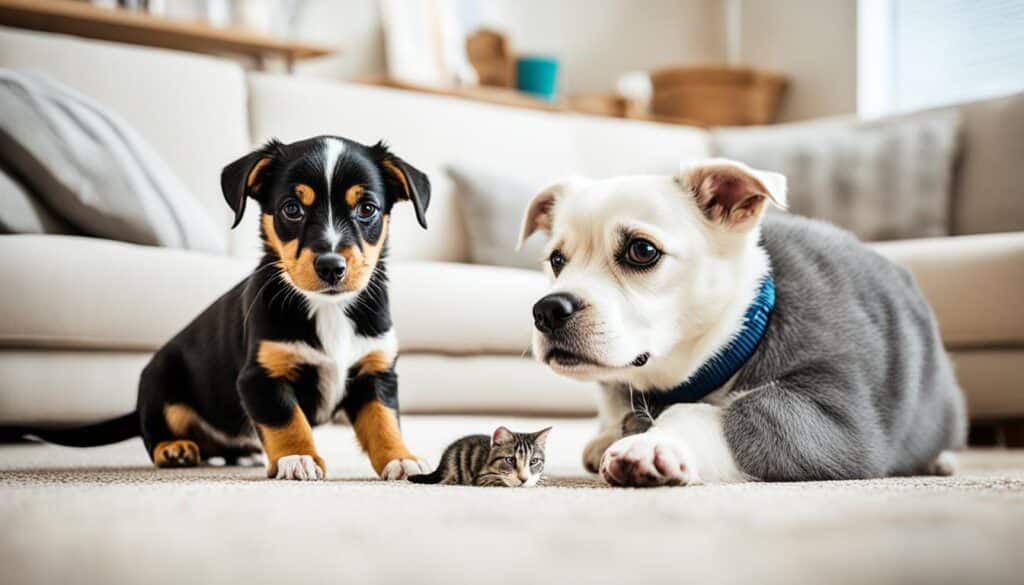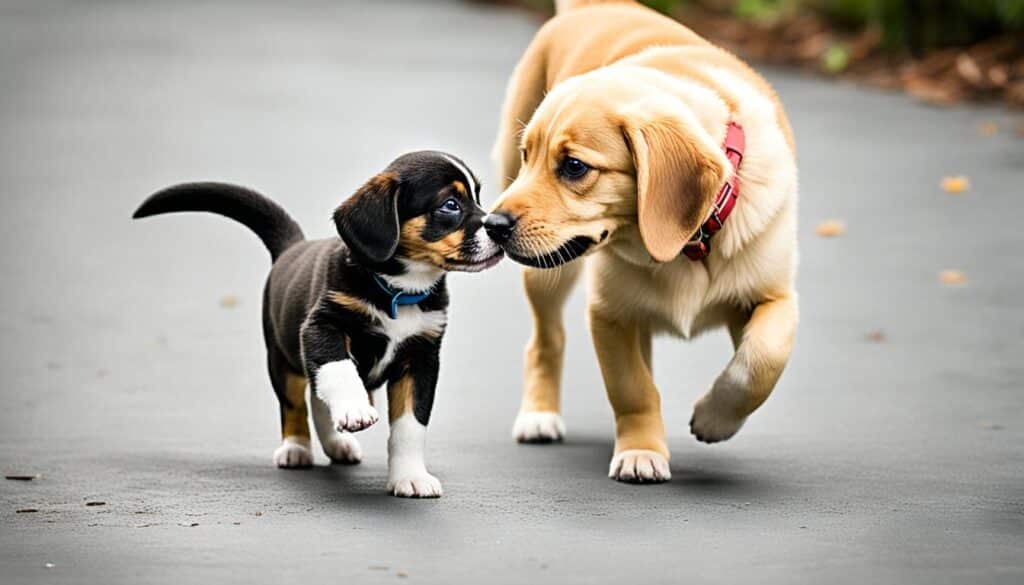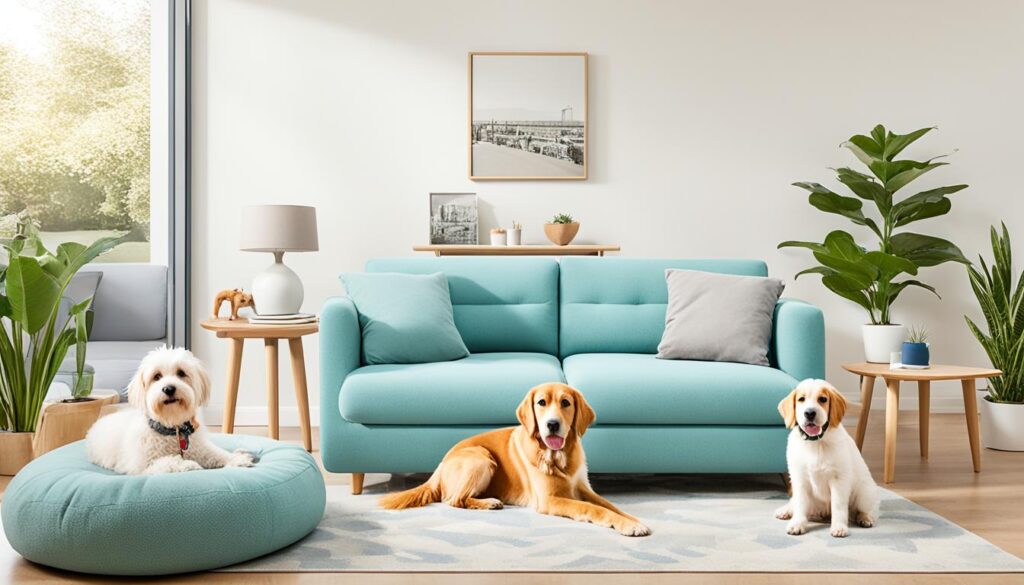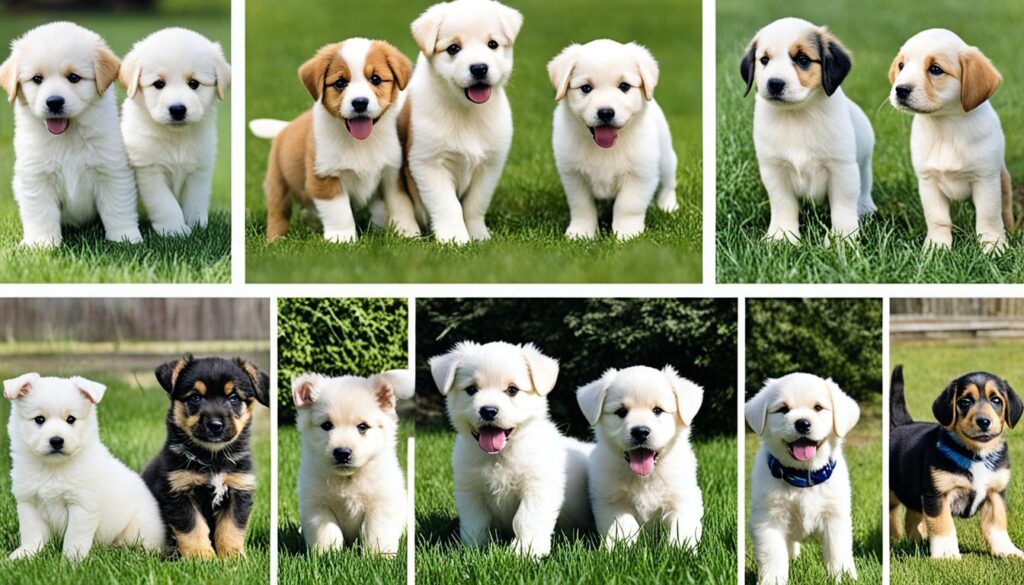Integrating a new puppy into a multi-pet household can be exciting but challenging. Whether you have cats, dogs, or a combination of furry friends, introducing a puppy requires careful planning and preparation to ensure a harmonious transition for everyone involved. This article will provide valuable tips and advice for successfully integrating a puppy into a multi-pet household.

Key Takeaways:
- Proper preparation is essential for the smooth integration of a new puppy into a multi-pet household.
- Designate separate spaces for the puppy to eat, sleep, and play to prevent territorial conflicts.
- Scent swapping before a physical meeting can help familiarize the pets with each other’s smells.
- Supervise the first introduction between the new puppy and existing pets in a neutral location.
- During the integration process, monitor and address the specific needs of puppies and older dogs.
Preparation is Key
Proper preparation is essential when integrating a puppy into a multi-pet household. By preparing and creating suitable spaces for your pets, you can help ensure a smooth and successful transition for everyone involved.
Setting up separate spaces
One of the first steps in preparing for a new puppy is to designate separate areas for them to eat, sleep, and play. This helps avoid territorial conflicts with your existing pets and allows each pet to have their own safe space. Providing separate food bowls, beds, and toys can also help prevent tension and competition.
Scent swapping
Before physically introducing your pets, consider exchanging blankets or toys between them to teach their smells. This process, known as scent swapping, can help familiarize them with each other’s scents and reduce anxiety and tension during their first meeting. It’s a gradual way to introduce the idea of a new addition to the household.
Crate and barrier training
Crate and barrier training are valuable tools for integrating a new puppy into a multi-pet household. Teaching the puppy to spend time in a crate can provide them with a safe and secure space while also giving your existing pets a sense of comfort, knowing they have their areas. Using baby gates or other barriers can help control interactions and gradually introduce the puppy to the other pets without overwhelming them.
The First Introduction
The first introduction between the new puppy and existing pets is crucial in establishing positive relationships within a multi-pet household. It sets the tone for future interactions and helps the pets get acquainted. To ensure a smooth and safe introduction, consider the following steps:
Choose a neutral location.
When introducing a new dog to your pets, choosing a neutral location is essential to avoid territorial conflicts. Places like a local park or open outdoor space can provide a neutral ground where no pet feels a possessive attachment. This neutral location helps to reduce tension and creates a more relaxed environment for the first meeting.
Supervised and short
Keep the initial meeting brief and closely supervised.Although it might be tempting to let the pets interact without restrictions, a brief initial meeting provides them with an opportunity to understand each other without feeling overwhelmed or overstimulated. Close supervision ensures that any signs of tension or potential conflicts can be immediately addressed.
Reading body language
During the first introduction, it’s essential to closely observe and interpret the body language of both the puppy and the older pets. Look for signs of tension, such as raised fur, growling, or stiff body posture, which may indicate discomfort or potential aggression. Conversely, signs of relaxation, such as a loose wagging tail, relaxed body posture, and friendly sniffing, indicate that the pets are comfortable with each other. Understanding and interpreting body language cues ensures a safe and harmonious interaction.

Addressing Specific Needs: Puppy vs. Mature Dog
When integrating a new puppy into a multi-pet household, it’s essential to understand that puppies have different needs and energy levels than matured dogs. Managing these specific needs is crucial to ensure the comfort and well-being of the puppy and the older dogs in the household.
The Energetic Nature of Puppies
Puppies are known for their high energy levels and enthusiasm. However, this energy can sometimes overwhelm and irritate older dogs who prefer a more relaxed environment. It’s essential to provide appropriate outlets for the puppy’s energy.
Regular exercise and playtime sessions can help manage their energy levels and prevent them from becoming overly rambunctious. Consider incorporating activities such as interactive games, obedience training, and walks to burn off excess energy in a controlled manner.
Potty Training a Puppy
Potty training is crucial to addressing a puppy’s needs in a multi-pet household. Training your puppy to relieve themselves in designated areas promotes cleanliness, helps establish a routine, and reduces the chances of accidents in the house.
Consistency and positive reinforcement are essential when it comes to potty training. Establish a regular schedule for bathroom breaks, reward your puppy for successful outings, and be patient when accidents happen. With time and guidance, your puppy will learn to associate the appropriate location for potty breaks.
Handling Puppy Accidents
Even with our most diligent efforts, accidents may still happen during the potty training process. Handling these accidents calmly and without punishing the puppy is essential, as this can lead to fear or anxiety-related issues.
When accidents happen, clean the affected area thoroughly to eliminate any residual odors that may attract the puppy to repeat the behavior. Using enzymatic cleaners can be particularly effective in removing odors that may not be noticeable to humans but can still draw the puppy.
| Potty Training Tips | Handling Puppy Accidents |
| Establish a consistent potty training scheduleDesignate specific areas for bathroom breaksUse positive reinforcement when the puppy successfully goes in the right spotBe patient and avoid punishing accidents | Clean accidents thoroughly with enzymatic cleanersAvoid using ammonia-based cleanersUse positive reinforcement for proper bathroom behaviorConsider using puppy training pads as a temporary solution |
Maintaining Routines for Resident Pets
In a multi-pet household, introducing a new puppy can disrupt the existing routines and dynamics. To ensure a smooth transition and reduce stress for the resident pets, it is crucial to maintain consistent care and routines for them. This section will discuss the importance of preserving feeding, exercise, and playtime routines, providing security and stability for the resident pets.
The Importance of Consistency
Consistency is vital in maintaining routines for resident pets in a multi-pet household. Older pets thrive on predictability and structure; any changes can cause anxiety and stress. By keeping their daily activities consistent, such as feeding, walks, and playtime, the resident pets can feel more secure and adapt more quickly to the new addition of a puppy.
Feeding Routine:
- Establish a consistent feeding schedule for all the pets in the household.
- Ensure each pet has their designated eating area and separate food bowls to prevent competition and resource guarding.
- Please stick to the same time each day to feed the pets, as this helps them anticipate and feel comfortable with their routine.
Exercise Routine: Regular exercise is essential for all pets’ physical and mental well-being. Maintain a consistent exercise routine for the resident pets, ensuring they get their daily physical activity. This might include regular walks, play sessions, or interactive toys to engage the pets and keep their energy levels balanced.
Playtime Routine: Playtime is crucial for bonding and mental stimulation. Set aside dedicated playtime sessions for the resident pets to engage with them individually and maintain their sense of importance and connection. Interactive play, such as fetch or puzzle toys, can provide mental enrichment and help reduce any potential feelings of neglect or jealousy.
Maintaining consistent care and routines for resident pets can reduce their overall stress levels, leading to a better integration process and a harmonious multi-pet household.

| Routine | Benefits |
| Feeding Routine | Prevents competition and resource guarding among pets |
| Exercise Routine | Maintains physical and mental well-being |
| Playtime Routine | Promotes bonding and mental stimulation |
Managing Daily Life in a Multi-Pet Household
Daily management is crucial in creating a harmonious environment for pets in a multi-pet household. Implementing effective strategies can prevent competition, promote quality time, and ensure appropriate behavior among pets.
Separate Feeding Times: Preventing Competition and Resource Guarding
Feeding time can be a common trigger for pet competition and resource guarding. Establishing separate feeding areas for each pet to prevent conflicts is essential. This helps minimize tension and ensures that each pet receives the necessary nutrition without feeling threatened or anxious.
Individual Attention: Ensuring Quality Time with Your Pets
Each pet, including the new puppy, deserves individual attention to thrive in a multi-pet household. Set aside dedicated time for bonding and engaging with each pet to avoid feelings of neglect and reinforce the human-animal bond. This quality time is crucial for their overall well-being, whether it’s cuddling, playing, or going for walks.
Monitoring Interactions and Play: Teaching Appropriate Behavior
Supervising pet interactions and play is essential in teaching appropriate behavior and preventing potential conflicts. Observe their body language, ensure fair play, and intervene if necessary. This helps create a safe and positive environment where pets can learn and grow together.
Toys and Play in a Multi-Pet Household
In a multi-pet household, selecting suitable toys is crucial to ensure each pet’s enjoyment and prevent conflicts. Appropriate toys promote harmony and enrich the playtime experience for all pets.
Choosing Suitable Toys
When choosing toys for a multi-pet household, it’s essential to consider the preferences and needs of each pet. Some pets may enjoy playing with others, while others may prefer their space. Here are some tips to keep in mind:
- Shared Toys: Consider purchasing toys that multiple pets can enjoy. These can include interactive toys encouraging group play, such as puzzles or treat-dispensing. Make sure to choose durable and safe toys that can withstand rough play.
- Individual Toys: Providing each pet with their toys is also essential. This gives them a sense of ownership and a dedicated playtime experience. Please consider each pet’s preferences and choose toys catering to their needs.
By offering a mix of shared and individual toys, you can accommodate your pets’ different play styles and preferences, promoting a positive play environment.
Structuring Playtime
Managing playtime in a multi-pet household is vital to ensure fair play and maintain a harmonious atmosphere. Here are some strategies for structuring playtime:
- Teaching Sharing: If appropriate, take the time to teach your pets how to share toys. Please encourage them to take turns and reward good behavior. This can prevent possessiveness over toys and foster a cooperative play atmosphere.
- Managing Play Sessions: Supervising play sessions and intervening if any tensions arise is essential. Observe your pets’ behavior during playtime and redirect their focus if necessary. Set boundaries and establish rules to create a safe and enjoyable play environment.
Additionally, ensure that each pet gets equal attention and playtime. Spending quality time with each pet individually can help prevent feelings of neglect and address their specific needs.
Featured Table
| Shared Toys | Individual Toys |
| Encourages group play | Allows for personal playtime |
| Durable and safe for multiple pets | Caters to individual preferences |
| Reduces conflicts over toys | Gives pets a sense of ownership |
Potential Challenges and Solutions
Integrating a new puppy into a multi-pet household can present various challenges. Addressing these challenges promptly is essential to ensure a harmonious environment for all pets involved.
Common issues:
Jealousy among pets is a common challenge when introducing a new puppy. Existing pets may feel threatened by the newcomer and exhibit behavior such as attention-seeking or territorial aggression. Resource guarding can also arise when pets become possessive over food, toys, or space. Over-exuberant puppy play can also overwhelm older or more reserved pets, leading to conflicts or stress.
Management tips:
Managing these challenges requires patience, consistency, and training. Here are some helpful tips:
- Provide individual attention: Ensure each pet receives quality time and attention to prevent feelings of neglect and reduce jealousy. This helps establish a positive bond and reassures existing pets that they are still valued family members.
- Gradual introductions: Allow pets to acclimate to each other’s presence through scent swapping and controlled interactions. This helps them become more familiar with one another and reduces tension during initial meetings.
- Positive reinforcement: Use rewards and praise to encourage good behavior and reinforce positive associations between pets. This can help address resource guarding and encourage appropriate play behaviors.
- Supervise and redirect: Monitor interactions between pets and intervene when necessary. If play becomes too rough or one pet exhibits aggressive behavior, turn their attention to a toy or engage them in a different activity to prevent conflicts.
- Create a safe environment: Provide each pet with a designated feeding area and separate toys to reduce competition and resource guarding. This helps ensure that all pets can access their essential needs without feeling threatened.
Addressing these challenges and implementing effective management strategies can create a harmonious and happy multi-pet household where all pets can thrive.
When to Seek Professional Help
While most pet owners can successfully integrate a new puppy into a multi-pet household, there are instances where professional help may be necessary to address persistent aggression or severe stress in pets.
Persistent aggression:
If any dog shows lasting aggression despite your efforts to manage and train them, it is crucial to seek professional help. A professional trainer or behaviorist can assess the situation and provide tailored strategies to address the aggression and ensure all pets’ safety.
Signs of severe stress:
If you notice significant anxiety or fear in any of your pets during the integration process, it is essential to consult a trainer or behaviorist. These professionals can identify the underlying causes of the stress and guide how to alleviate it, allowing your pets to feel more comfortable and secure in their new dynamic.
Unsure how to proceed:
If you feel overwhelmed or need more certainty about navigating the integration process, seeking personalized guidance from a trainer or behaviorist can be immensely valuable. They can assess your situation, offer practical advice, and create a customized plan to help you build a happy and harmonious multi-dog home.
FAQs
Q: How long can a puppy adjust to a multi-pet household?
A: The adjustment period varies. Some puppies fit in quickly, while others may take weeks or months. Be consistent and patient.
Q: My resident dog is ignoring the puppy. Is this a problem?
A: Not necessarily. It may be your dog’s way of processing the change. Keep interactions positive and give your resident dog space if needed.
Q: Should I let the puppy and resident dogs play unsupervised right away?
A: No, always supervise interactions until you are confident they have a positive dynamic. Separate them when unsupervised.
Q: Should I feed all my pets in the exact location?
A: Initially, feeding them separately is wise to reduce competition and stress. You may gradually transition feeding areas closer together as they adjust.
Q: What if my older dog growls at the puppy?
A: Growling can be a typical form of communication. However, if it escalates to aggression or the puppy seems fearful, separate them and consider consulting a professional trainer.

